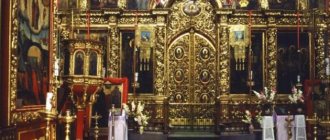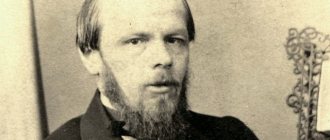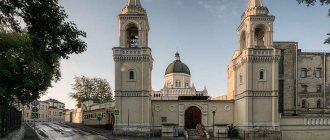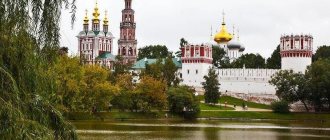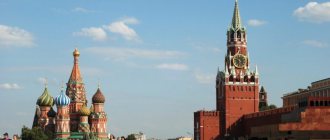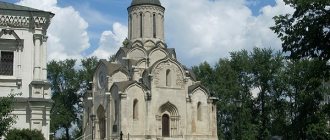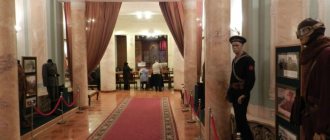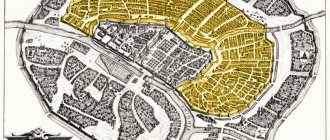The Cathedral of the Holy Apostles Peter and Paul is the Lutheran Church of the Holy Apostles in Moscow, the main cathedral of the regional Evangelical Lutheran Church of the European part of Russia. Divine services are held every Sunday in Russian and German.
Cathedral of Peter and Paul - Lutheran church in Moscow with an organ
The parish of the Church of Saints Peter and Paul in Moscow is one of the oldest Lutheran parishes in Russia. The cathedral is one of two operating official Lutheran churches in the capital of the Russian Federation, together with the Church of the Holy Trinity at the Vvedensky cemetery.
Story
The land for the construction of the temple was given to the Lutherans by decree of Peter II in 1727. A year later, the first stone was laid on this site.
It took only two years to complete construction. The temple was consecrated in 1730 in honor of Saints Peter and Paul.
The structure was built of brick and topped with a wooden turret. The temple could accommodate up to 1,500 people at a time. A few years later, two houses were built next to the church, which housed a school and housing for temple servants.
The church building was gradually destroyed, and in 1832 they decided to demolish the old one and build a new religious building. The winner of the project competition was Alexander Bryullov. The new church was completed in 1838 .
The main decoration of the temple was a painting by Karl Bryullov depicting the crucifixion. In the sixties of the 19th century, bells appeared in the tower. A major renovation of the building was carried out at the end of the century. The author of the work to change the interior decoration and bring it to a unified style was M. Messmacher. The interior decoration was done with bright polychrome painting. At the same time, marble figures of two apostles were installed .
The twentieth century was destructive for many places of worship. The temple was closed, property was expropriated, church ministers were shot. For a long time the building was not used for its intended purpose. In 1958, the Soviet government decided to build a swimming pool in the Lutheran church building .
With the beginning of perestroika, it became possible to negotiate the return of the temple to believers. The building was returned to the Lutheran community in 1993 , at which time the church became the Cathedral.
Cathedral of St. Peter and Paul
Cathedral Church of Peter and Paul in Moscow - poster, concert tickets, schedule, hall layout.
The Evangelical Lutheran Cathedral, the Church of Saints Peter and Paul on Starosadsky Lane, is an active cathedral that hosts organ music concerts. Concerts are held here during free time from services, thereby opening up the opportunity for everyone (regardless of beliefs and views) to join the thousand-year-old cultural heritage of Russia and Europe.
The first Lutherans appeared in Moscow in the 16th century. These were artisans, doctors and merchants invited from Europe. And already in 1694, Peter I founded a Lutheran stone church in the name of the holy apostles Peter and Paul - which was consecrated a year later, in his personal presence. During the Great Moscow Fire of 1812, the temple burned down. And the parish acquired the Lopukhins’ estate near Pokrovka, on Starosadsky Lane. With the funds of the King of Prussia, Frederick William III, as well as with the participation of Alexander I, in June of the following year, the reconstruction of the purchased house into a church began - a dome and a cross were erected. On August 18, 1819, the temple was consecrated. In February 1837, an organ sounded there for the first time. In 1862, a reconstruction was carried out in the neo-Gothic style, according to the plan of the architect A. Meinhardt. And in 1863, a bell, donated by Kaiser Wilhelm I, was raised to the tower.
The church played a huge role not only in the religious, but also in the musical life of Moscow - famous Moscow and foreign performers performed there. It is enough to mention the organ concert of Franz Liszt, which took place on May 4, 1843.
On December 5, 1905, the church was consecrated as the Cathedral of the Moscow Consistorial District. In 1918, the cathedral received the status of the Cathedral of Russia, and then of the entire Soviet Union.
However, in the post-revolutionary years, persecution of religion began in the USSR. The building was taken away from the community. In 1937, the cathedral was converted into the Arktika cinema, and then transferred to the Filmstrip studio. The redevelopment carried out, unfortunately, completely destroyed the entire interior. In 1941, the church organ was evacuated to the Novosibirsk Opera House, where it was partially scrapped and partially used as decoration. And before the World Festival of Youth and Students in 1957, the cathedral spire was dismantled.
In July 1992, by decree of the Moscow Government, the building was returned to the community. And in 2004, after much effort, we managed to find sponsors, both among individuals and among organizations. This made it possible to begin large-scale restoration work. Finally, on November 30, 2008, during a solemn service, the consecration of the revived cathedral took place.
Currently, in addition to divine services, the cathedral hosts numerous concerts - musical instruments sound, amazing voices sing, and magical music comes to life. The SAUER organ installed opposite the altar (built in 1898 by Wilhelm Sauer, one of the largest organ-building firms in Germany) is one of the few romantic organs of the nineteenth century preserved in Russia. The unique acoustics of the Evangelical Lutheran Cathedral of Saints Peter and Paul makes it possible to fully enjoy its sound.
Architecture
Interior decoration
Protestant churches are distinguished by their simplicity of decoration and some asceticism. The Church of Saints Peter and Paul is no exception. The grandeur of the temple is emphasized by the white painted walls.
The restorers were unable to restore the interior decoration; the interior had undergone too many changes.
A side spiral staircase takes visitors to the second floor.
The new worship hall is now directly above the pool bowl . The floor level was raised by 4 meters, which led to disruption of acoustics. The basements of the temple were painted with Christian symbols in 2000 and are called “catacombs”. Under the altar there is a chapel and a cross. The walls, painted white, emphasize the grandeur of the temple.
Exterior decoration
Externally, the structure resembles Lutheran churches built in Western Europe in the middle of the last millennium. On the main facade there is an arch and two three-tier towers. In the center on the cornice is a figure of a cherub with a cross. On both sides of the main entrance there are figures of Saints Peter and Paul. The external decoration is strict and uncomplicated.
Figure of St. Peter near the Lutheran Church. It was Peter who was the first among the disciples to call the Teacher Christ, that is, the Messiah. For this, the Lord nicknamed him Stone - this is how the name Peter is translated. On this stone of Peter’s faith, the Lord promised to create His Church, which the gates of hell will not overcome.
Figure of St. Paul near the Lutheran Church. Paul was not a disciple of Christ during the Savior’s earthly life. Moreover, he was a persecutor of Christians.
Who are Lutherans?
Lutheranism is one of the oldest Protestant movements in Christianity. The very emergence of the concept of Protestantism is connected with Lutheranism, since it was Lutherans who began to be called Protestants after their protest in Speyer.
The basic principles of the Lutheran Church's doctrine were formulated during the struggle of Martin Luther and his associates against the abuses of the Roman Catholic Church.
Lutherans, like Catholics, consider themselves Trinitarian theists (Holy Trinity) and profess the Divine-human nature of Jesus Christ, crucified on the cross, descended into hell, resurrected and ascended to heaven, so that at the end of time he would come again to judge the living and the dead.
Martin Luther and his followers against the Catholic Church
An important place in the doctrine is occupied by the concept of original sin, which can be overcome solely by the action of grace expressed in faith. They consider the Bible to be the main and only criterion for the correctness of faith.
Lutherans recognize two sacraments: baptism and communion. Through baptism people become Christians. In communion they are strengthened in faith. A feature of Lutheran communion within the Western tradition is that all believers, not just priests, receive communion with the chalice.
Schedule of services in 2021
Sunday
- 11.30 – divine service with Holy Communion in the cathedral in Russian
- 14.00 – service in the chapel in French
Thursday
- 19.00 – divine service with Holy Communion in the chapel in Russian
Architecture of the Lutheran Cathedral
The Cathedral of Peter and Paul attracts visitors with its unique and unusual architecture for Moscow. It combined neo-Gothic, features of the Romanesque style and elements of Art Nouveau.
Complex of buildings at the cathedral:
- The almshouse occupies buildings 2 and 4.
- The chapel, originally a chapel for funerals of the dead, occupies building 6, built in 1892. During the Soviet years it was closed along with the cathedral. In May 1992, the chapel was returned to the community.
The chapel was consecrated at Easter 1993, and construction work was finally completed in October of the same year.
Regular Sunday services in Russian and German were held in the chapel until the fall of 1998, as well as during construction and restoration work in the cathedral.
- The fence with gate was built in 1892.
- The janitor's guardhouse is located in building No. 7.
- The parable house was built in the 1880s. The building also housed the Moscow Consistory of the ELC.
- The Pokoinitskaya at the chapel occupies building 9.
- The Petropavlovsk Men's School is located in building 3. Built in 1912-1913. Currently, the building houses the National Medical Research Center for Preventive Medicine of the Ministry of Health of the Russian Federation.
- The residential building for the teachers of the men's school was built in 1912-1913.
- Petropavlovsk Women's School (red brick building). During the Soviet years, the building was built on two floors.
Until 2004, pre-restoration work was carried out to dismantle the communications remaining after the Filmstrip. With the support of the city, a new electrical substation was installed, the insulating layer of the vaults and the roof were replaced, and the western façade with the main entrance and the neo-Gothic rose window were restored based on old photographs.
In 2004, when the cathedral found sponsors among individuals and organizations, the opportunity arose to begin large-scale work to restore the historical appearance of the cathedral, taking into account modern technical requirements.
In January 2010, the spire was completely restored; the height of the cathedral with the spire was 62 meters.
The area surrounding the cathedral also underwent changes: many years of asphalt layers in the courtyard were removed, as a result of which its level dropped almost to the level of 1905.
Organ concerts
But it is not only the unique appearance of the temple that attracts Muscovites and guests of the capital. The Cathedral of the Holy Apostles Peter and Paul in Moscow is worth visiting at least once, even if you do not consider yourself a Protestant.
In addition to regular services, which take place every Sunday morning at 11.30 in Russian and German, organ music concerts are held here, attracting hundreds of listeners. Within the walls of the existing Lutheran church is one of the oldest organs in Russia. Its mesmerizing sounds are heard during church services.
Thanks to the ascetic decoration and unique acoustics of the cathedral, the powerful sounds of the organ sound especially authentic here. Prominent organists from all over the world often come here on tour.
In addition to religious music, you can also hear many secular works here. As part of the International Bach Festival, the musical and installation project “Night in the Cathedral” took place within these walls.
Church interiors
In 2004-2008, the hall was cleared of unnecessary ceilings and partitions, the vault, walls and badly damaged columns were restored. The gallery encircling the hall on three sides was restored, new doors were made and old ones were restored, and new oak benches were installed.
The installation of a restored organ, marble floor and stained glass windows in the apse windows was carried out. In addition, work was carried out to restore and waterproof the basements, install electrical, heating and ventilation systems.
In July 2011, students of the Riga Art School installed in the cathedral a new neo-Gothic altar with carved pointed arches and spiers, a hanging pulpit with a canopy, a new font, and a stand for the Easter candle, created from valuable species of oak, linden and pine.
The young craftsmen also installed a balustrade separating the altar from the central nave, thereby transforming the altar space of the cathedral.
